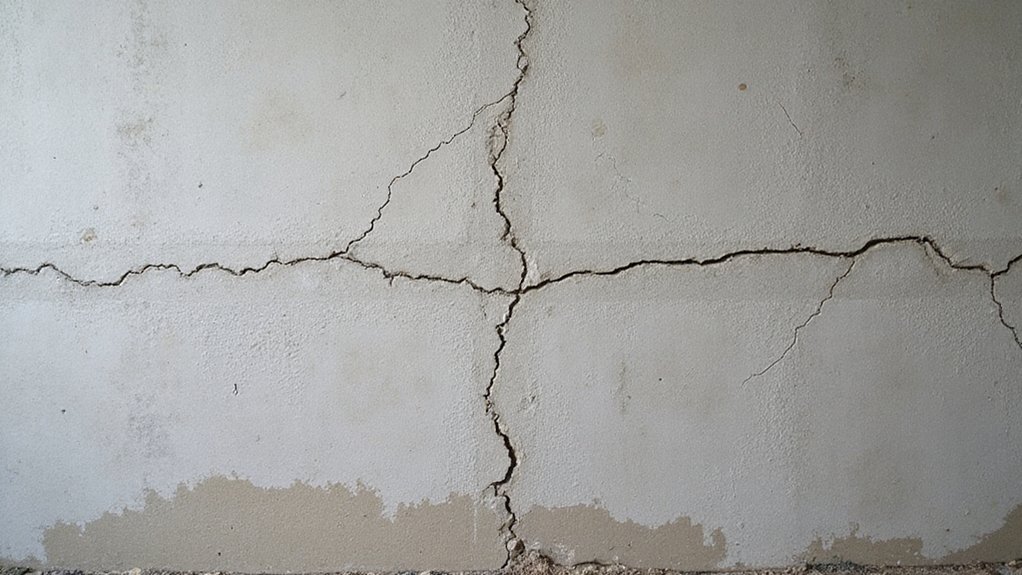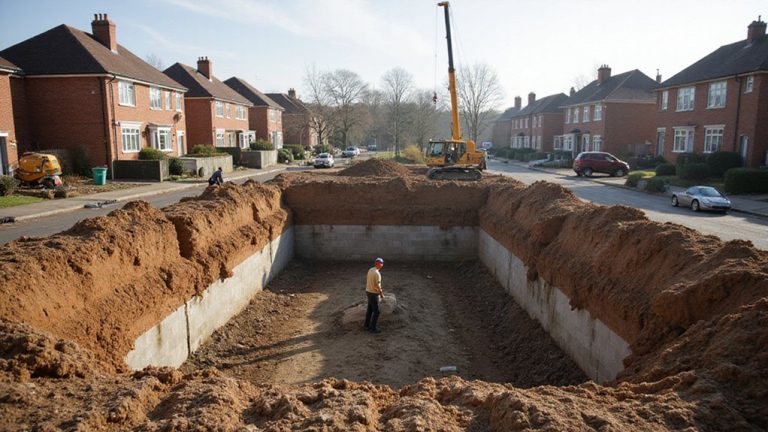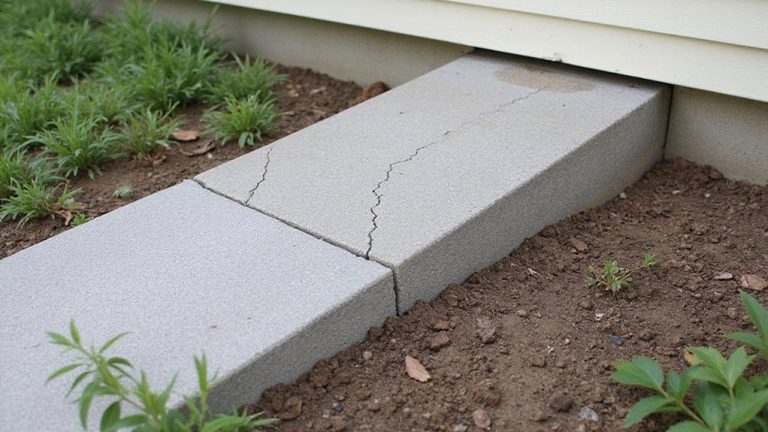Identifying basement wall cracks early is essential to prevent them from worsening and causing significant structural damage. By understanding the different types of cracks and their underlying causes, you can take proactive steps to address the issue before it escalates. From hairline fractures to diagonal or horizontal breaks, each crack tells a story about the health of your home’s foundation. Regularly inspecting your basement walls can help you detect the early signs of foundation movement and take the necessary measures to safeguard your investment.
Common Types of Basement Wall Cracks
Basement wall cracks can take on various forms, each with its own unique characteristics and potential causes. Hairline cracks, for instance, are thin, linear fractures that may appear as a result of minor foundation settling or concrete shrinkage.
Wall discoloration can also indicate the presence of cracks, as moisture infiltration can lead to staining or efflorescence. These subtle signs shouldn’t be overlooked, as they can escalate into more serious structural issues if left unchecked.
Understanding the different types of basement wall cracks is the first step in identifying and addressing the underlying problems before they worsen. Diagonal and horizontal cracks can potentially grow and become costly to repair if not addressed promptly by a foundation specialist.
Causes of Basement Wall Cracks
While basement wall cracks can be concerning, understanding their potential causes is the first step in resolving the issue. Fluctuations in soil moisture levels and hydrostatic pressure are common culprits.
When the soil around your home becomes overly saturated, the increased water pressure can force its way through the walls, leading to cracks. Likewise, drought conditions can cause the soil to shrink, putting stress on the basement walls.
Other factors, like poor construction, settling, or even nearby tree roots, can also contribute to wall cracks. Identifying the root cause is vital for addressing the problem effectively.
Soil moisture and temperature can significantly impact foundation stability, with extreme conditions potentially leading to horizontal or diagonal cracking in basement walls.
Identifying the Signs of Basement Wall Cracks
Although finding cracks in your basement walls can be alarming, recognizing the warning signs early is crucial for addressing the issue effectively. Look for uneven wall thickness or bulges, which could indicate soil settlement or foundation movement.
Inspect the walls closely, paying attention to any cracks, no matter how small – these may be signs of a larger structural problem. Additionally, examine the floor and note any sloping or unevenness, as this can suggest the walls are shifting. By staying vigilant and identifying the signs of basement wall cracks, you can take proactive steps to protect your home.
Assessing the Severity of Basement Wall Cracks
Evaluating the severity of basement wall cracks is essential for determining the appropriate course of action. Measuring the depth of the cracks can help gauge their significance.
If the cracks are shallow, a few millimeters deep, they may be merely cosmetic. Deeper cracks, an inch or more, could indicate structural issues. Consistently monitoring the progression of the cracks is also paramount. Are they widening or lengthening over time? This can signal worsening problems.
Appraising the severity allows you to take the necessary steps to address the problem before it escalates, preserving the safety and integrity of your home.
Preventing Further Deterioration of Basement Wall Cracks
Once you’ve assessed the severity of the basement wall cracks, it’s essential to take prompt action to prevent further deterioration. Continuous monitoring is key – regularly inspect the cracks for changes in size or depth.
Early intervention is vital; address any signs of worsening immediately. Seal smaller cracks with a concrete sealant to stop moisture intrusion. For larger cracks, consult a professional who can recommend effective repair methods, such as epoxy injection or wall reinforcement.
Addressing basement wall cracks swiftly will safeguard your home’s structural integrity and prevent costly future repairs. Don’t delay – act now to protect your investment.
Temporary Solutions for Basement Wall Cracks
While addressing basement wall cracks through permanent solutions is ideal, sometimes you may need to ponder, reflect on, or weigh temporary fixes to stabilize the issue and prevent further damage.
Consider these temporary solutions:
- Applying a flexible, waterproof patch to cracks and holes to stop moisture intrusion
- Improving drainage around the foundation to mitigate moisture buildup
- Installing a dehumidifier or moisture barrier to control humidity and dampness
- Sealing cracks with a concrete sealant or epoxy-based filler to prevent expansion
These temporary measures can provide relief while you examine more thorough solutions for the long term.
Permanent Repair Options for Basement Wall Cracks
Three permanent solutions can effectively address basement wall cracks and provide long-lasting results. Epoxy injection repairs are a popular choice, as they fill and seal the cracks, restoring the wall’s structural integrity. This process involves injecting a specialized epoxy resin into the crack, which hardens and bonds the cracked surfaces together.
Carbon fiber reinforcement is another effective option. This method involves applying carbon fiber strips to the wall’s surface, creating a strong, durable overlay that reinforces the damaged area. Both solutions offer reliable and long-lasting results, ensuring your basement stays dry and secure.
Seeking Professional Assistance for Basement Wall Cracks
If you’ve unearthed cracks in your basement walls, it’s best to seek professional assistance to properly address the issue.
Look for qualified contractors with experience in basement waterproofing and foundation repair.
Evaluate contractor credentials, including licenses, insurance, and customer reviews.
Schedule a thorough inspection to determine the cause and extent of the cracks.
Work with the contractor to develop a customized plan for repairing the cracks and safeguarding against further damage.
Locating the right professional can grant you peace of mind and guarantee the long-term stability of your home’s foundation.
Frequently Asked Questions
How Do I Inspect My Basement Walls for Cracks?
Regularly perform a visual inspection of your basement walls to check for signs of cracks or damage. This helps maintain the structural integrity of your home and provides a sense of security.
Can Basement Wall Cracks Be Fixed by Myself?
You can fix some basement wall cracks yourself using DIY repair methods, but it’s best to have a professional assess the structural integrity first. This verifies the issue is addressed properly and doesn’t worsen over time.
What Is the Best Way to Prevent Future Basement Wall Cracks?
Prevent future basement wall cracks by implementing moisture control techniques like waterproofing and utilizing structural reinforcement methods like installing wall anchors. Taking these proactive steps can safeguard your home and provide a sense of security.
How Much Does It Cost to Repair Basement Wall Cracks?
The cost to repair basement wall cracks can vary greatly, typically ranging from $500 to $3,000 or more. Professional inspection fees start around $100-$300, but they’ll guarantee the issue is properly diagnosed and remedied.
When Should I Call a Professional for Basement Wall Cracks?
You should call a professional when you notice a significant crack size or sporadic crack appearance in your basement walls. Addressing basement cracks early on can help maintain the security and value of your home.



